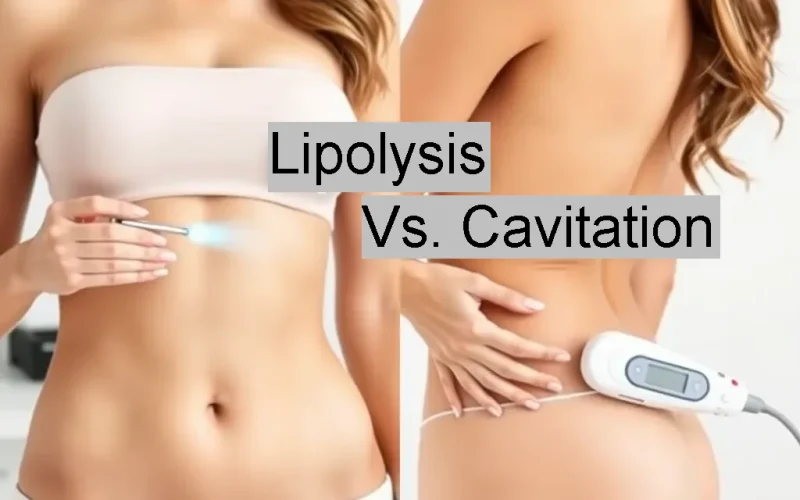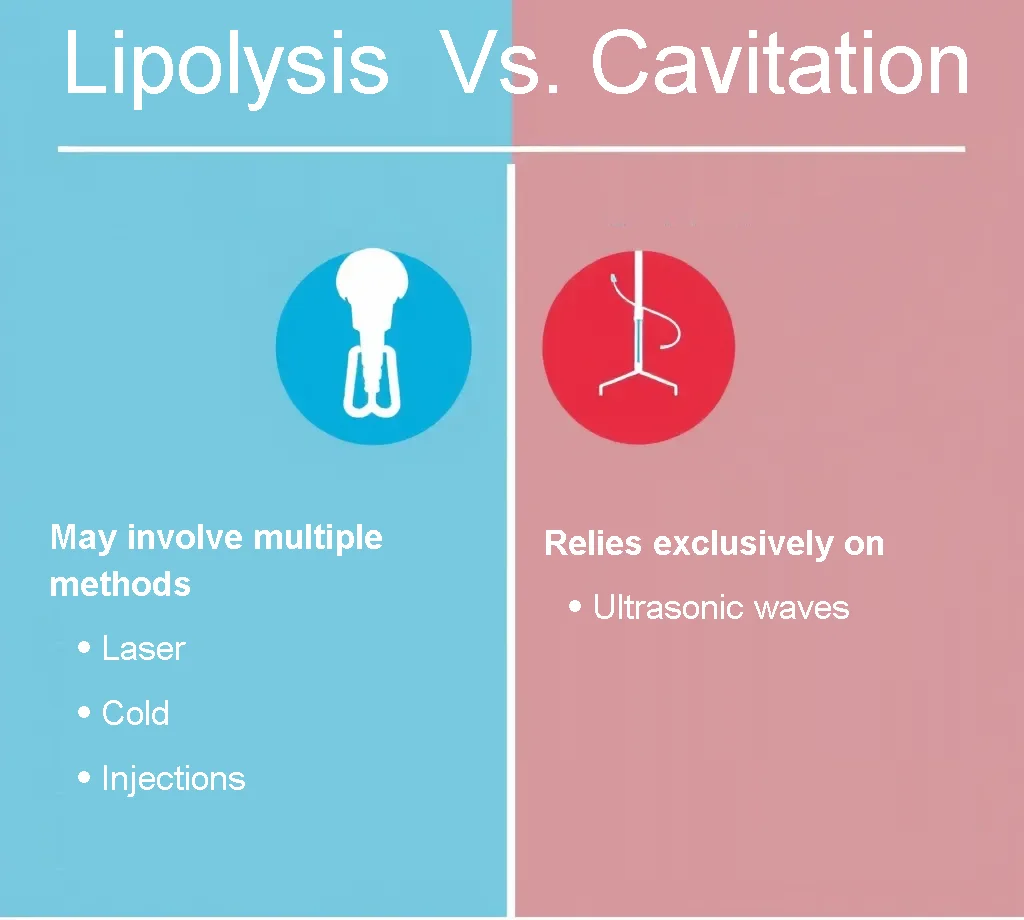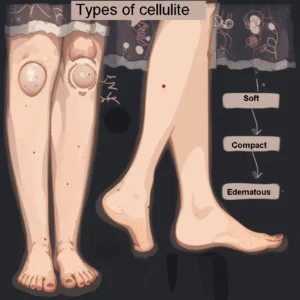

Differences between lipolysis and cavitation
Differences between lipolysis and cavitation: which is the best option for you?
In the competitive world of non-invasive aesthetic treatments, many people are looking for safe, effective, and surgery-free options to improve their figure. Among the most popular techniques are lipolysis and cavitation, known for their excellent results and minimal invasiveness. Although both pursue the same goal—localized fat reduction—their methods, benefits, indications, and limitations differ significantly.
Therefore, it’s essential to fully understand each technique before deciding which one best suits your needs. Below, we’ll explain in clear and detailed detail everything you need to know to make an informed and personalized decision.
1. What is lipolysis?

Lipolysis destroys fat cells so the body can eliminate them naturally. There are several modalities: laser, injectable, and cryolipolysis.
- Laser lipolysis uses low-intensity light to break down fat cell membranes.
- The injectable version applies substances that chemically dissolve fat.
- In cryolipolysis, cold freezes localized fat and causes it to break down.
Thanks to its localized focus, it allows specific areas to be treated with great precision. Since it doesn’t require surgery, recovery is quick, which is ideal for those who don’t want to interrupt their routine.
2. What is cavitation?
Cavitation uses low-frequency ultrasound to generate microbubbles within fatty tissue. These bubbles implode, damage adipocyte membranes, and release the fat, which is then naturally eliminated by the lymphatic system.
This treatment is painless, fast, and requires no anesthesia or downtime. People seeking to reduce body volume without invasive methods often benefit especially from cavitation. With the right number of sessions and healthy habits, the results are visible and consistent.
3. Differences between lipolysis and cavitation: Applied technology
Each technique is based on different technologies. Lipolysis combines different methods such as laser, cold, or injectable substances, allowing for greater customization. Cavitation, on the other hand, focuses on ultrasonic waves, which facilitates its application over large areas and reduces costs.
Both are effective. However, the type of fat and the area being treated will determine which is most suitable. Therefore, a professional evaluation is key before beginning.
4. Possible Side Effects and Risks
Although both treatments are safe, there is always the possibility of side effects, although these are usually mild and temporary.
- Lipolysis: May cause swelling, redness, or mild bruising, especially with the injectable form. In very rare cases, some localized discomfort or an allergic reaction may occur.
- Cavitation: Generally, it does not produce significant side effects. However, some people may experience a slight sensation of warmth or hear ringing in the ears during the session.
To minimize any risk, it is recommended to visit certified centers with approved equipment and properly trained professionals.
5. Results and Treatment Duration
Both procedures require consistency to achieve visible results, although they differ in the speed with which these results appear.
- Lipolysis: Depending on the type of technique used, results may appear from the first session (as with laser) or take several weeks (as with cryolipolysis).
- Cavitation: Typically requires between 6 and 12 sessions to achieve a noticeable effect. The exact number will depend on the patient’s metabolism, lifestyle, and level of commitment to post-treatment instructions.
In both cases, the results are longer-lasting when accompanied by a balanced diet, regular exercise, and consistent hydration.
6. Indications and Contraindications
Both lipolysis and cavitation are aimed at people with localized fat who want to improve their silhouette without resorting to surgery. However, each treatment has its own indications:
- Lipolysis: Ideal for small areas such as the double chin, arms, or lower abdomen.
- Cavitation: More suitable for large areas such as the thighs, buttocks, and entire abdomen.
Both techniques are contraindicated in pregnant women, people with pacemakers, severe cardiovascular disease, or advanced liver dysfunction. They should also be avoided in patients with active infections in the treatment area.
7. Costs and accessibility: Differences between lipolysis and cavitation
The difference in cost is another aspect to consider. Lipolysis, especially its laser or cryogenic versions, is usually more expensive per session due to the high-end technology and specialized training required.
Cavitation, on the other hand, has a more affordable price per session. However, since multiple applications are required to achieve optimal results, the total cost can be comparable to that of lipolysis.
Therefore, choosing one procedure or the other will depend on both aesthetic goals and available budget.
8. Possibility of combining both treatments
An increasingly common option is to combine lipolysis with cavitation in a personalized comprehensive plan. Although these techniques are different, their effects can effectively complement each other when applied strategically.
For example, lipolysis can be used to remove fat in small areas and then cavitation can be applied to improve overall body contour. This combination not only accelerates results but also improves skin definition and firmness.
However, this approach must be designed and supervised by an aesthetic medical professional to ensure safe and efficient application.
9. Specific advantages of each technique
Lipolysis:
- Allows for greater customization
- Is effective with fewer sessions
- Ideal for treating small areas
- Offers a variety of application methods
Cavitation:
- Comfortable and painless treatment
- Requires no recovery time
- Suitable for large areas of the body
- Compatible with active lifestyles
Both techniques offer satisfactory results if applied correctly, but their choice should be based on the type of fat, body area, and the patient’s medical history.
10. Recommendations before and after treatment
Both before and after each session, following certain recommendations can make a big difference in the results obtained.
Before treatment:
- Drink at least two liters of water a day
- Avoid alcoholic and caffeinated beverages
- Avoid heavy or fatty meals
- Inform your professional about your medications and medical history
After treatment:
- Maintain a balanced diet
- Engage in moderate physical activity
- Continue to stay well hydrated
- Avoid alcohol consumption for the next 48 hours
These habits promote fat loss and help maintain long-term results.
11. Differences between lipolysis and cavitation: Which is the best option for you?
Understanding the differences between lipolysis and cavitation is key to choosing the most appropriate treatment. If you want fast results in small areas and are willing to invest a little more, lipolysis may offer the ideal solution. However, if you prefer a more economical, gradual, and pain-free option, cavitation could be your best option.
In any case, the most important thing is to receive a professional evaluation before starting any treatment. This is the only way to ensure that the chosen technique is safe, effective, and customized to your needs. Although these procedures can offer significant benefits, they do not replace a healthy lifestyle; rather, they complement it.
Explore other related articles by clicking here and Visit the official website here




